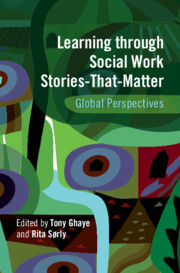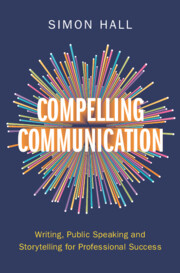Refine search
Actions for selected content:
98 results
Chapter 1 - Why Are Stories of Social Work Important?
- from Introduction
-
-
- Book:
- Learning through Social Work Stories-That-Matter
- Published online:
- 28 August 2025
- Print publication:
- 11 September 2025, pp 3-19
-
- Chapter
- Export citation
Chapter 15 - Partner in Decolonization
- from Part I - Storying-to-Learn: How Stories-that-Matter Help Us Appreciate Social Work in Action
-
-
- Book:
- Learning through Social Work Stories-That-Matter
- Published online:
- 28 August 2025
- Print publication:
- 11 September 2025, pp 200-215
-
- Chapter
- Export citation
Community-Engaged Podcasting with Hidden Heroes in a Small Town
- Part of
-
- Journal:
- Public Humanities / Volume 1 / 2025
- Published online by Cambridge University Press:
- 03 September 2025, e132
-
- Article
-
- You have access
- Open access
- HTML
- Export citation

Learning through Social Work Stories-That-Matter
- Global Perspectives
-
- Published online:
- 28 August 2025
- Print publication:
- 11 September 2025
What Were We Thinking? A Climate Fiction Beginning and Ending, Told Inside and Outside and Backward and Forward
-
- Journal:
- Australian Journal of Environmental Education , First View
- Published online by Cambridge University Press:
- 26 August 2025, pp. 1-24
-
- Article
-
- You have access
- Open access
- HTML
- Export citation
11 - Growing Up Globally – Middle Childhood
- from Section II - Middle Childhood
-
- Book:
- Child Development
- Published online:
- 19 June 2025
- Print publication:
- 12 June 2025, pp 166-176
-
- Chapter
- Export citation
2 - Storytelling and/as Misinformation
-
-
- Book:
- Governing Misinformation in Everyday Knowledge Commons
- Published online:
- 13 March 2025
- Print publication:
- 20 March 2025, pp 18-40
-
- Chapter
-
- You have access
- Open access
- HTML
- Export citation
Learning to Live with Dungalaba: Embracing Indigenous Knowledge Practises for Respectful Coexistence with Saltwater Crocodiles in the Northern Territory
-
- Journal:
- Australian Journal of Environmental Education , First View
- Published online by Cambridge University Press:
- 17 March 2025, pp. 1-14
-
- Article
-
- You have access
- Open access
- HTML
- Export citation
Mothers of Sierra Leone: Improving Maternal Health through Storytelling
- Part of
-
- Journal:
- Public Humanities / Volume 1 / 2025
- Published online by Cambridge University Press:
- 24 February 2025, e63
-
- Article
-
- You have access
- Open access
- HTML
- Export citation
Chapter 6 - Conjuring Nineteenth-Century Black Environmentalism
-
-
- Book:
- The New Nineteenth-Century American Literary Studies
- Published online:
- 02 January 2025
- Print publication:
- 23 January 2025, pp 83-97
-
- Chapter
- Export citation
Co-design of “Baatcheet,” a peer-supported, web-based storytelling intervention for young people with common mental health problems in India
-
- Journal:
- Cambridge Prisms: Global Mental Health / Volume 11 / 2024
- Published online by Cambridge University Press:
- 16 December 2024, e128
-
- Article
-
- You have access
- Open access
- HTML
- Export citation
20 - ‘The Story Is Part of the Success’
- from Part II - Designing Effective Governance Mechanisms
-
-
- Book:
- Implementing Climate Change Policy
- Published online:
- 22 November 2024
- Print publication:
- 05 December 2024, pp 313-328
-
- Chapter
- Export citation
Echoes Through Time: Transforming Climate Litigation Narratives on Future Generations
-
- Journal:
- Transnational Environmental Law / Volume 13 / Issue 3 / November 2024
- Published online by Cambridge University Press:
- 05 November 2024, pp. 547-568
-
- Article
-
- You have access
- Open access
- HTML
- Export citation
Which client is worthy of using discretion? Analysing storytelling practices of Dutch street-level bureaucrats in inter-departmental settings
-
- Journal:
- Journal of Social Policy , First View
- Published online by Cambridge University Press:
- 18 September 2024, pp. 1-20
-
- Article
-
- You have access
- Open access
- HTML
- Export citation

Compelling Communication
- Writing, Public Speaking and Storytelling for Professional Success
-
- Published online:
- 30 May 2024
- Print publication:
- 30 May 2024
11 - Composing for the Screen
- from Part II - Techniques
-
-
- Book:
- The Cambridge Companion to Composition
- Published online:
- 25 May 2024
- Print publication:
- 30 May 2024, pp 164-174
-
- Chapter
- Export citation
4 - The Splendour of Storytelling
-
- Book:
- Compelling Communication
- Published online:
- 30 May 2024
- Print publication:
- 30 May 2024, pp 93-120
-
- Chapter
- Export citation
Introduction
-
- Book:
- Compelling Communication
- Published online:
- 30 May 2024
- Print publication:
- 30 May 2024, pp 1-4
-
- Chapter
- Export citation
A Compelling Conclusion (Hopefully)
-
- Book:
- Compelling Communication
- Published online:
- 30 May 2024
- Print publication:
- 30 May 2024, pp 319-324
-
- Chapter
- Export citation
2 - The Black Body and the Medical Archive
- from Part I - Extraction and Abstraction
-
-
- Book:
- The Cambridge Companion to the Black Body in American Literature
- Published online:
- 09 May 2024
- Print publication:
- 16 May 2024, pp 32-48
-
- Chapter
- Export citation
